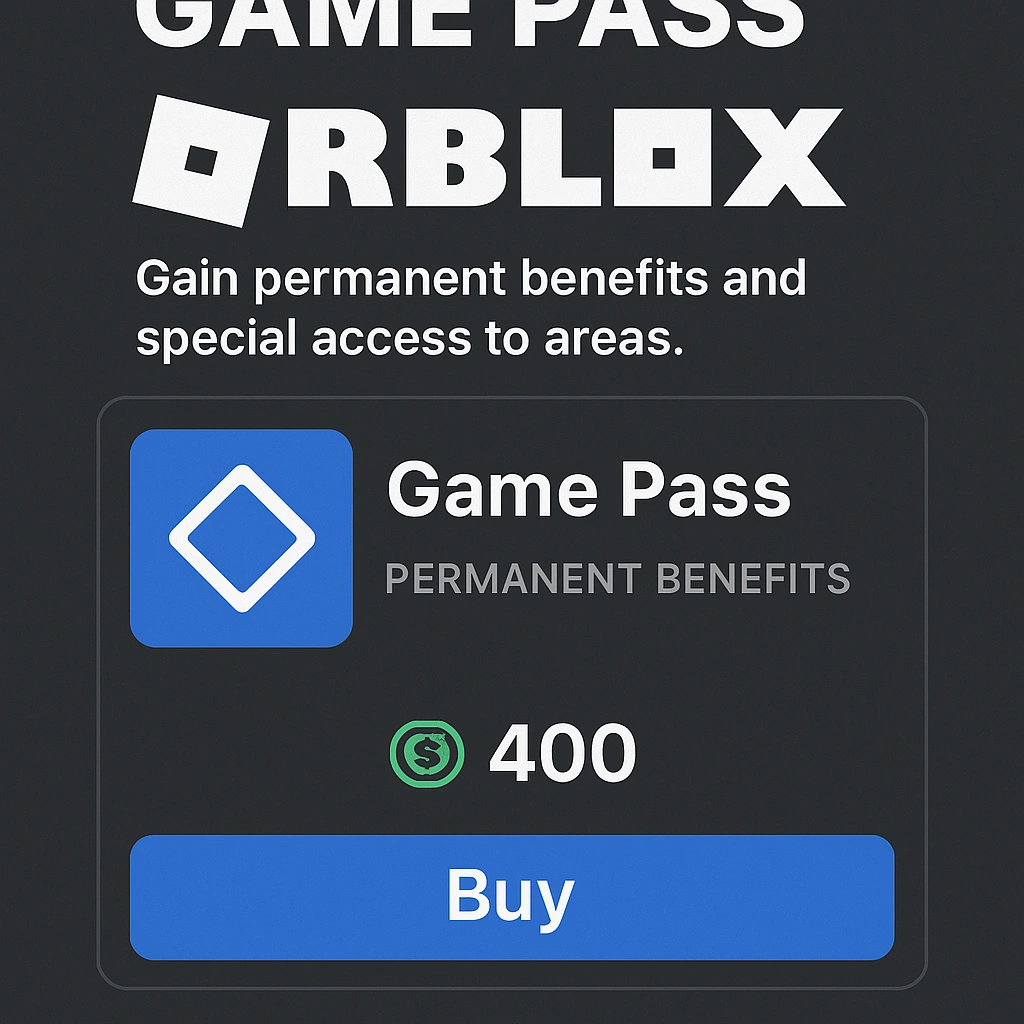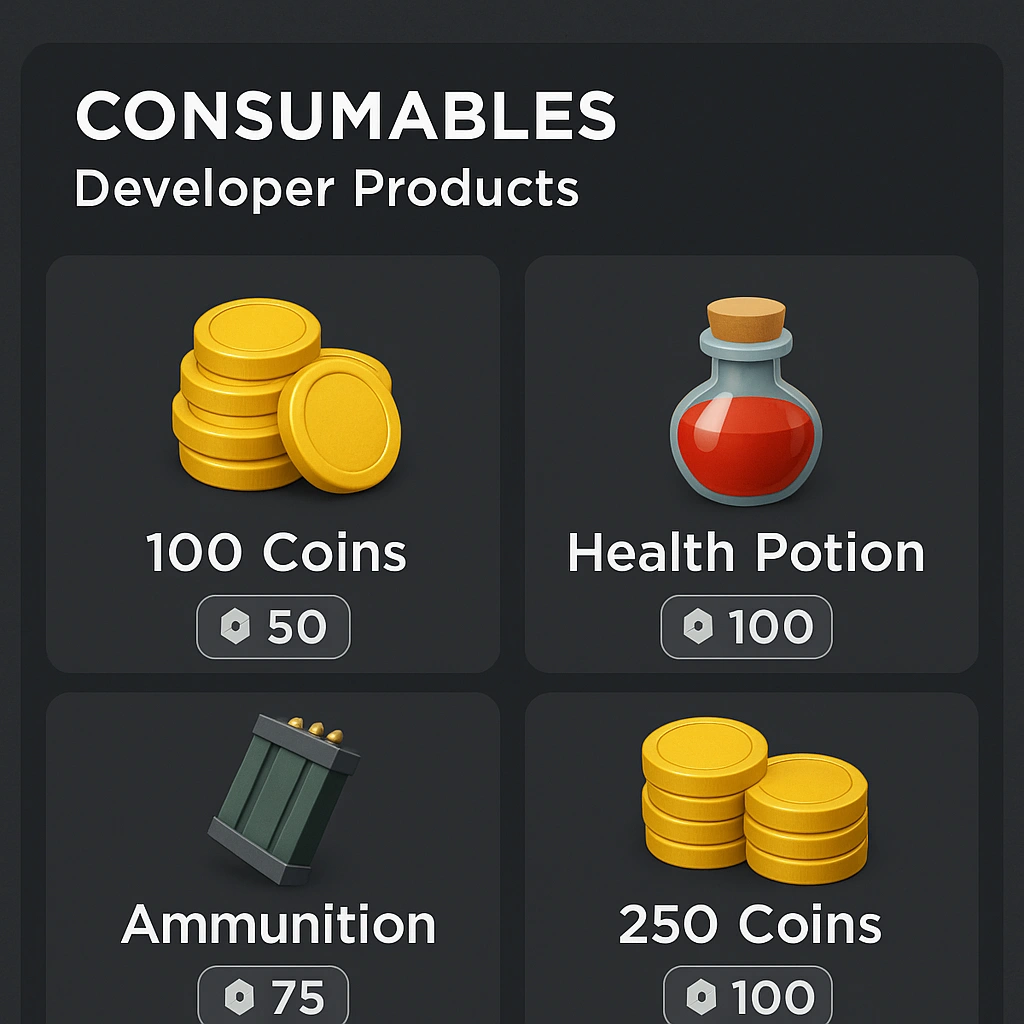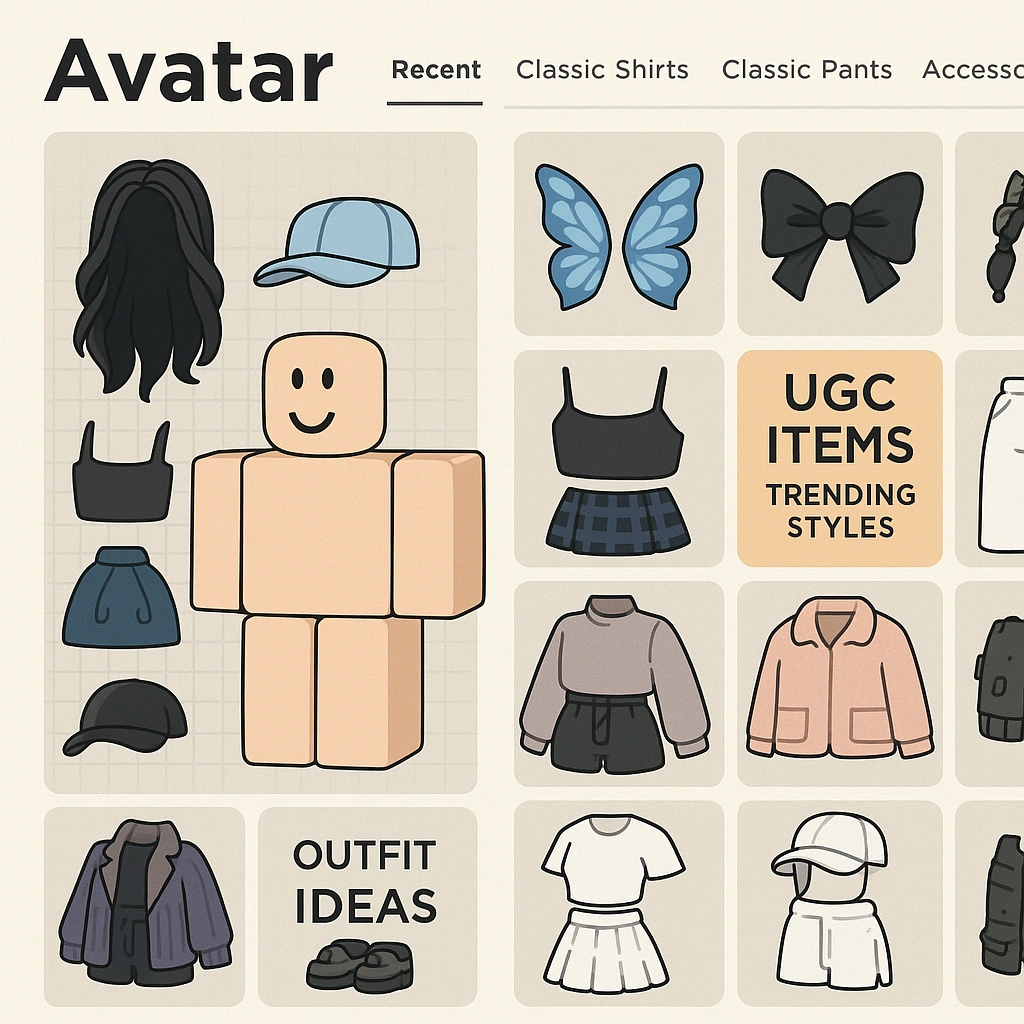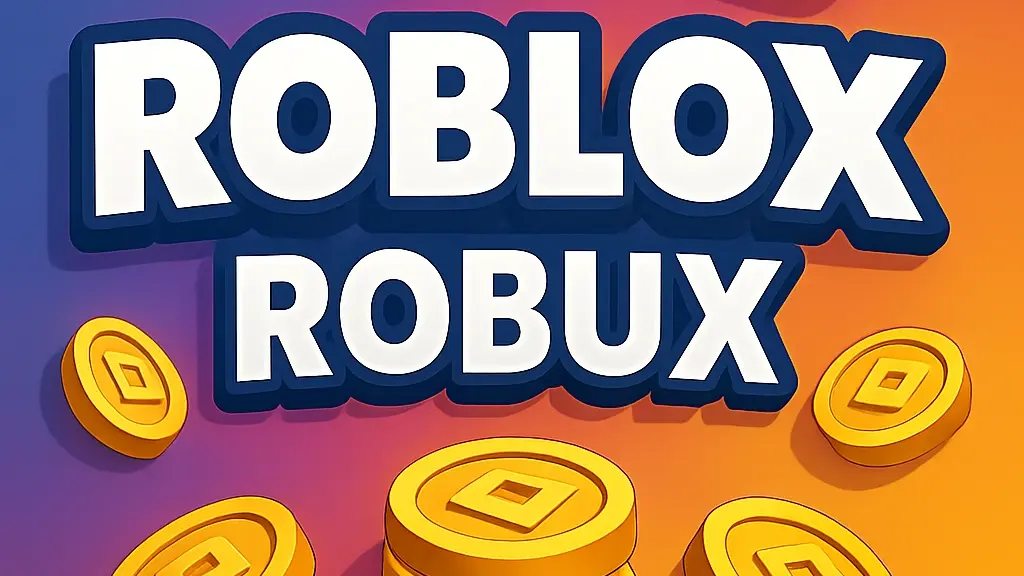
Choosing the right monetization approach can make or break your Roblox game’s success. While both Game Passes and Developer Products offer powerful ways to generate Robux revenue, understanding their distinct advantages is crucial for maximizing your earnings potential. Game Passes work best for permanent, one-time benefits that enhance player experience, while Developer Products excel at consumable items that create recurring purchase opportunities.
Table Of Contents
- 1 Understanding Game Passes: The Foundation of Permanent Benefits
- 2 Developer Products: Maximizing Recurring Revenue Streams
- 3 Avatar Customization and UGC Monetization Trends
- 4 Comparing Revenue Models and Market Performance
- 5 Strategic Implementation Guidelines
- 6 Integration with Avatar Customization Trends
- 7 Platform Evolution and Future Opportunities
- 8 Best Practices for Sustainable Revenue Growth
- 9 Conclusion
- 10 FAQ
Understanding Game Passes: The Foundation of Permanent Benefits
Game Passes serve as your gateway to offering exclusive, permanent privileges within your Roblox experience. These one-time purchases grant players access to special areas, unique avatar items, permanent power-ups, or enhanced gameplay features that persist across gaming sessions.

Key Advantages of Game Passes
Game Passes offer several compelling benefits for developers seeking sustainable monetization. Visibility plays a crucial role – passes appear directly under your game on the platform, incentivizing players to make additional purchases. This prominent placement significantly increases conversion rates compared to hidden monetization options.
The permanence factor makes Game Passes particularly attractive to players. Once purchased, these benefits transfer between different experiences, adding substantial value to the investment. This cross-game compatibility encourages players to view passes as worthwhile long-term purchases rather than temporary boosts.
Restoration capabilities provide another major advantage. Developers can easily restore player purchases if technical issues arise, and compensate players for unpopular changes without complex coding implementations. The streamlined management system allows for quick disabling of purchases when necessary.
Revenue Structure for Game Passes
When players purchase your Game Passes, you earn 70% of the Robux spent. This revenue share applies consistently across all pass sales, providing predictable income calculations for your monetization strategy. For passes created by other developers sold within your experience, you earn a 10% affiliate fee while the original creator receives 60%.
Developer Products: Maximizing Recurring Revenue Streams
Developer Products represent consumable items or abilities that players can purchase multiple times, such as in-game currency, ammunition, health potions, or temporary boosts. Unlike Game Passes, these products don’t provide permanent benefits but instead offer immediate satisfaction and utility.

Strategic Applications for Developer Products
The consumable nature of Developer Products creates powerful recurring revenue opportunities. Players frequently purchase items like virtual currency to accelerate progress, health boosts during challenging gameplay, or special ammunition for competitive advantages. This repeat purchase model can generate significantly more revenue per player compared to one-time Game Pass sales.
Implementation flexibility allows developers to integrate products seamlessly into gameplay mechanics. You can prompt purchases at strategic moments when players need specific items, creating natural buying opportunities without disrupting the gaming experience.
Technical Considerations
Developer Products require more complex implementation than Game Passes. You must properly process sales receipts using the ProcessReceipt API and validate each purchase for User ID, Developer Product ID, and receipt status. This technical overhead ensures secure transactions but requires careful coding to prevent data loss.
Avatar Customization and UGC Monetization Trends
The Roblox avatar customization market represents a massive opportunity for creators, with the platform selling over a billion digital fashion items in 2022. Understanding current fashion guide trends and UGC items popularity can significantly boost your monetization success.

Current Market Trends
Trending styles heavily influence purchasing decisions, with 84% of Gen-Z users admitting their virtual avatar style impacts real-world fashion choices. This cross-platform influence creates substantial demand for high-quality avatar items and accessories.
The outfit ideas market shows remarkable growth potential, with 52% of Gen-Z users comfortable budgeting up to $10 monthly for avatar styling9. Limited-edition items can command premium prices, with some community-created pieces reaching $10,0009.
Revenue Opportunities in UGC
UGC items creators face initial investment requirements of 2,250 Robux (750 for upload, 1,500 for sales listing). However, successful items can generate substantial returns despite the 30% revenue share model that leaves creators with 70% of sales proceeds.
The fashion guide community actively seeks trending items, particularly those inspired by popular brands or seasonal themes. Creators who understand these trends and produce timely content often achieve the highest success rates in the competitive UGC marketplace.
Comparing Revenue Models and Market Performance
Both monetization methods operate under Roblox’s standard 30% platform fee structure. Developers consistently receive 70% of gross sales regardless of whether they use Game Passes or Developer Products. This uniform revenue share ensures fair compensation across different monetization approaches.
Recent data shows developers earned $922.8 million in 2024 through the Developer Exchange Program, representing an increase from $740 million in the previous year. This growth demonstrates the platform’s expanding monetization potential for creators who implement effective strategies.
Market Performance Indicators
Engagement-based payouts supplement traditional sales revenue, with Premium subscribers generating additional income based on playtime in your experience. This passive income stream rewards creators who build compelling, long-term engagement rather than focusing solely on immediate purchases.
The platform’s Daily Engagement Reward program provides creators with 5 Robux per “active spender” who plays for at least 10 minutes daily and has spent $9.99+ on Roblox within two months. For popular experiences, this can generate substantial supplementary income.
Strategic Implementation Guidelines
Choosing the Right Monetization Mix
Permanent benefits work best as Game Passes – special weapons, exclusive areas, permanent power-ups, or unique avatar items that enhance the core experience. These purchases should feel valuable and enhance rather than gatekeep essential gameplay elements.
Consumable items suit Developer Products perfectly – temporary boosts, virtual currency, revival tokens, or cosmetic effects that players naturally want to repurchase. Focus on items that provide immediate gratification without creating pay-to-win scenarios.
Pricing Psychology and Market Positioning
Fair pricing strategies significantly impact conversion rates. Research suggests starting with competitive pricing ranges: 25-500 Robux for Game Passes and 5-100 Robux for individual Developer Products. Monitor player feedback and adjust pricing based on perceived value and market response.
Value communication proves essential for both monetization methods. Players should clearly understand what they’re purchasing and how it enhances their gameplay experience. Detailed descriptions and preview systems help justify purchase decisions and reduce buyer’s remorse.
Integration with Avatar Customization Trends
Roblox avatar customization continues driving significant revenue, with new features like Physically Based Rendering (PBR) for accessories launching in 2025. Creators who incorporate fashion elements into their monetization strategy can tap into this lucrative market segment.
Trending styles and seasonal content create natural urgency for purchases. Limited-time items or seasonal collections often outperform permanent catalog additions due to scarcity psychology and social desire to participate in current trends.
Platform Evolution and Future Opportunities
New Revenue Models
Roblox recently introduced paid-access experiences, allowing creators to charge real money for game access, with revenue shares ranging from 50-70% depending on price points ($9.99, $29.99, or $49.99). This model currently applies only to desktop purchases but represents significant expansion opportunities.
Subscription-based models offer another emerging revenue stream, with Roblox providing reduced platform fees (15% instead of 30%) for developers who integrate subscriptions before specified deadlines. This incentive structure encourages adoption of recurring revenue models.
Technology Improvements
Enhanced analytics and performance tracking tools provide deeper insights into player behavior and purchase patterns. These improvements help creators optimize their monetization strategies based on actual user data rather than assumptions.
Try-on and bundle purchases functionality allows players to preview multiple items simultaneously and complete purchases in a single transaction. This streamlined shopping experience can significantly improve conversion rates for avatar-related monetization.
Best Practices for Sustainable Revenue Growth
Community Engagement Strategies
Building strong community connections enhances monetization success across all methods. Players who feel connected to your game and creator brand show higher purchase rates and lifetime value. Regular communication, community events, and responsive feedback handling contribute to sustainable revenue growth.
Social proof through community showcases and player testimonials can significantly boost monetization performance. When players see others enjoying purchased benefits or items, they’re more likely to make similar investments in their own gaming experience.
Ethical Monetization Principles
Value-first approaches ensure long-term success by prioritizing player satisfaction over short-term revenue extraction. Monetization should enhance rather than restrict core gameplay, creating positive associations with purchasing decisions.
Transparency in pricing and clear communication about what purchases include builds trust with your player base. Hidden fees, confusing descriptions, or misleading previews damage community relationships and reduce long-term monetization potential.
For comprehensive guidance on Roblox monetization strategies, including advanced techniques for earning, spending, trading, and cashing out, creators can access detailed resources that cover the complete monetization ecosystem.
Conclusion
Successfully monetizing your Roblox experience requires strategic thinking about player needs, purchase psychology, and platform mechanics. Game Passes excel for permanent benefits that add lasting value to the player experience, while Developer Products maximize recurring revenue through consumable items that integrate naturally with gameplay.
The key to sustainable success lies in understanding your audience, providing genuine value, and staying current with platform trends like avatar customization and UGC items. By implementing ethical monetization practices and leveraging both Game Passes and Developer Products strategically, creators can build thriving businesses that benefit both developers and players.
Remember that successful monetization is an iterative process. Monitor your analytics, gather player feedback, and continuously refine your approach based on performance data. The Roblox platform continues evolving with new features and opportunities, making adaptability essential for long-term success.
FAQ
Q: Should I use Game Passes or Developer Products for my Roblox game?
A: Use Game Passes for permanent benefits like special abilities, exclusive areas, or permanent power-ups that players purchase once. Choose Developer Products for consumable items like virtual currency, temporary boosts, or items players might buy multiple times. Many successful games use both strategically.
Q: What percentage of revenue do I keep from Game Pass and Developer Product sales?
A: You keep 70% of all sales from both Game Passes and Developer Products, with Roblox taking a 30% platform fee. This rate applies consistently across both monetization methods.
Q: How much should I price my Game Passes and Developer Products?
A: Start with competitive pricing: 25-500 Robux for Game Passes and 5-100 Robux for individual Developer Products. Monitor player feedback and adjust based on perceived value and conversion rates.
Q: Can I sell avatar customization items to increase revenue?
A: Yes, the avatar customization market is highly lucrative, with Roblox selling over a billion digital fashion items in 2022. UGC creators can earn from avatar items, though initial costs include 2,250 Robux for listing fees.
Q: What’s the difference between Game Passes and UGC items for monetization?
A: Game Passes provide gameplay benefits within your specific game, while UGC items are avatar customization assets sold on the broader Roblox marketplace. UGC items can generate revenue across the entire platform but require different creation skills and investment.
Q: How do engagement-based payouts work alongside Game Passes and Developer Products?
A: Engagement-based payouts provide additional revenue based on Premium subscriber playtime in your experience, supplementing sales from Game Passes and Developer Products. This creates passive income for engaging experiences.
Q: Are there minimum requirements for cashing out Robux earnings?
A: Yes, you need at least 30,000 Robux (approximately $375) to cash out through the Developer Exchange program, plus Premium subscription, verified email, and compliance with community standards.

